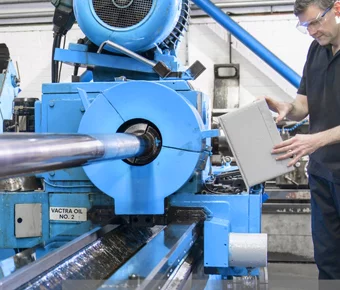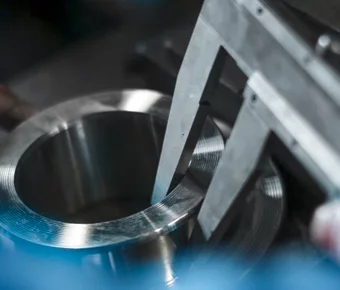1.4841 Stainless Steel – High Temperature Alloy for Demanding Industrial Applications
The 1.4841 material, also known as AISI 314 or X15CrNiSi25-21, is an austenitic, heat-resistant chromium-nickel stainless steel. Its excellent oxidation resistance at elevated temperatures makes it well-suited for applications in heat treatment equipment, furnaces, and process industries.
Heat-resistant Stainless Steel
1.4841 || AISI 314
Temperature Resistance of 1.4841 Material
1.4841 stainless steel performs reliably within a temperature range of 900 °C to 1120 °C. In air, it remains scale-resistant up to 1150 °C, making it suitable for continuous high-temperature exposure in industrial environments.
Corrosion Resistance of 1.4841 Stainless Steel
The material offers very good resistance in oxidizing atmospheres. In reducing, sulfur-containing gases, however, resistance is limited and recommended only up to 650 °C. Under carburizing or low-oxygen conditions above 900 °C, the material’s durability is moderate and may require consideration of alternatives.
Magnetic Properties of 1.4841 Material
Due to its austenitic microstructure, 1.4841 stainless steel is non-magnetic. Even after cold deformation, magnetic permeability remains low.
- Density: 7.9 kg/dm³
- Electrical resistivity: 0.90 Ω·mm²/m
- Thermal conductivity: 15 W/m·K
- Specific heat capacity: 500 J/kg·K
Typical Applications of 1.4841 Stainless Steel
1.4841 material is used in various high temperature applications, including:- Heat resistant equipment in industrial plants
- Components in the chemical and petrochemical industry
- Chains, furnace parts, and kiln equipment
- Automotive and construction industry
- Screens, grates, and thermally stressed structural elements
- Hot forming: 1150 – 800 °C, followed by air cooling
- Solution annealing: 1050 – 1150 °C, quenching in air or water
- Forging: 1175 – 1000 °C, followed by rapid cooling
- Can 1.4841 be welded?
- Yes, the material is weldable using all standard welding methods. Preheating or post-weld heat treatment is generally not required. However, due to its tendency toward hot cracking, welding energy input should be kept as low as possible.
- Machinability of 1.4841 Stainless Steel
- Similar to 1.4828, 1.4841 tends to form carbides, which can accelerate tool wear. High-performance cutting tools and intensive cooling are essential. The material’s work-hardening behavior requires reduced cutting speeds during machining.
Chemical Composition of 1.4841 (AISI 314)
This alloy is based on a stable chromium-nickel structure with increased silicon content:
| Chromium (Cr): | 24.0 – 26.0 % |
| Nickel (Ni): | 19.0 – 22.0 % |
| Silicon (Si): | 1.5 – 2.5 % |
| Carbon (C): | max. 0.20 % |
| Manganese (Mn): | max. 2.00 % |
| Phosphorus (P): | max. 0.045 % |
| Sulfur (S): | max. 0.015 % |
| Nitrogen (N): | max. 0.11 % |
Mechanical Properties at Room Temperature
| Hardness HB | ≤ 223 |
| Yield strength Rp 0.2 | ≥ 230 N/mm2 |
| Tensile strength Rm | 550 – 750 N/mm2 |
| Elongation A5 | ≥ 30 % |
| Modulus of elasticity: | approx. 196 kN/mm² |
Creep strength
Creep strength is the mechanical initial stress that causes a material to break after a certain period of stress duration and at a constant temperature above the transition temperature under constant tensile force.
| Temperature | 1 000 h | 10 000 h | 100 000 h |
|---|---|---|---|
| Temperature: 600 °C | 1 000 h: 170 N/mm2 | 10 000 h: 130 N/mm2 | 100 000 h: 80 N/mm2 |
| Temperature: 700 ° C | 1 000 h: 90 N/mm2 | 10 000 h: 40 N/mm2 | 100 000 h: 18 N/mm2 |
| Temperature: 800 °C | 1 000 h: 40 N/mm2 | 10 000 h: 20 N/mm2 | 100 000 h: 7 N/mm2 |
| Temperature: 900 °C | 1 000 h: 20 N/mm2 | 10 000 h: 10 N/mm2 | 100 000 h: 3 N/mm2 |
Creep limit
Creep limit is the initial stress that leads to a specified plastic deformation under constant tensile stress at a predetermined temperature and duration of stress.
| Temperature | 1 % Creep limit for 1,000 h | 10 000 h |
|---|---|---|
| Temperature: 600 °C | 1 % Creep limit for 1,000 h: 105 N/mm2 | 10 000 h: 95 N/mm2 |
| Temperature: 700 °C | 1 % Creep limit for 1,000 h: 50 N/mm2 | 10 000 h: 35 N/mm2 |
| Temperature: 800 °C | 1 % Creep limit for 1,000 h: 23 N/mm2 | 10 000 h: 10 N/mm2 |
| Temperature: 900 °C | 1 % Creep limit for 1,000 h: 10 N/mm2 | 10 000 h: 4 N/mm2 |
Coefficient of thermal expansion
Coefficient of thermal expansion for heat-resistant alloys, which have a high coefficient of thermal expansion and low thermal conductivity, leading to temperature and stress differences in a component or assembly. The coefficient of thermal expansion is expressed by the proportional length change for each degree of temperature increase, usually as 10 –6 K –1.
| Temperature | Coefficient of thermal expansion |
|---|---|
| Temperature: 200 °C | Coefficient of thermal expansion: 15,5 |
| Temperature: 400 °C | Coefficient of thermal expansion: 17,0 |
| Temperature: 600 °C | Coefficient of thermal expansion: 17,5 |
| Temperature: 800 °C | Coefficient of thermal expansion: 18,0 |
| Temperature: 1 000 °C | Coefficient of thermal expansion: 19,0 |
- EN 10216-5
- SEW 470
- ASME SA 312
The information provided on this page is non-binding. It serves only as orientation.
We cannot guarantee the results in processing and application of the products.

Tables and rates

Not the right steel available?
You will find the complete program for stainless steel piping systems in various materials for the highest requirements with us.







